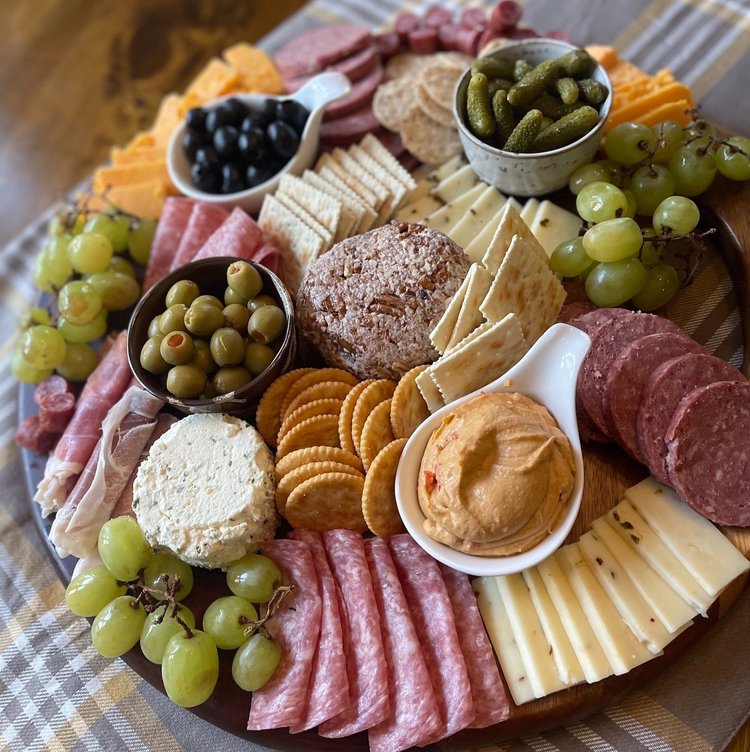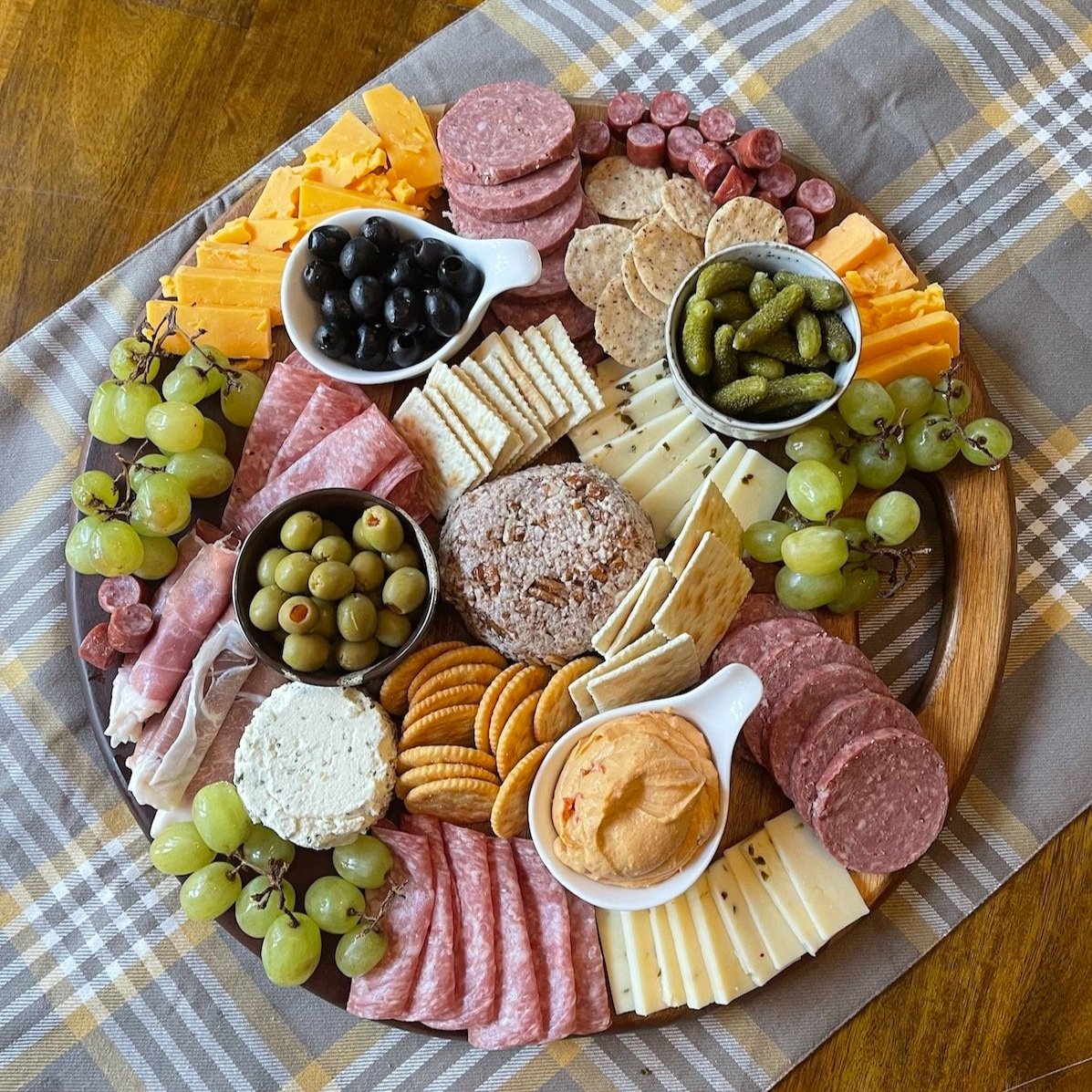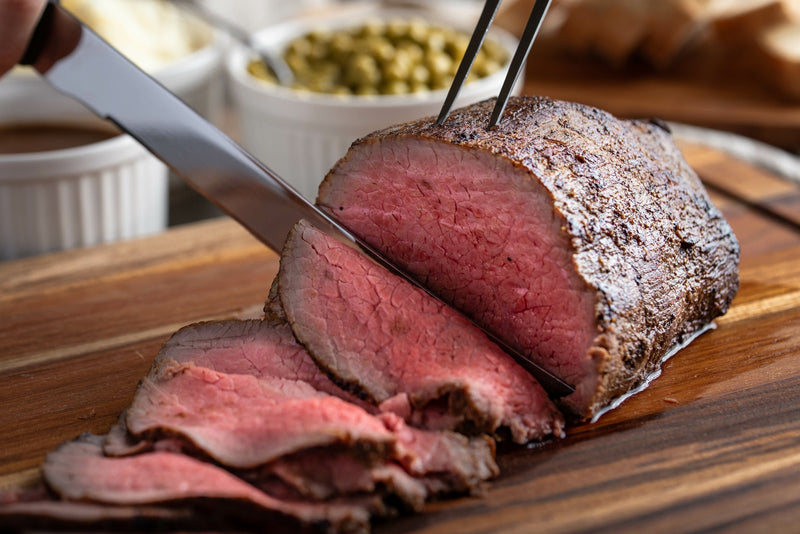
What is Charcuterie?
char·cu·te·rie | \ (ˌ)shär-ˌkü-tə-ˈrē \
: a delicatessen specializing in dressed meats and meat dishes
also : the products sold in such a shop
Nowadays, when people refer to a charcuterie board they are talking about a tray full of meats, cheeses, fruits, vegetable, breads, sauces, and anything else that they might want to add. This tray sits out so that the guests can help themselves to any of the bite sized items on it.
What type of board should you use?
You can be completely creative here. Any flat surface that is food safe can be used. Wooden cutting boards, ceramic or glass platters, slate trays. Or, line your dining table or kitchen island with butcher paper and lay out your charcuterie directly on it.
What Goes on a charcuterie platter?
The sky’s the limit. Anything that is bite sized can go on a charcuterie board. Using locally sourced meats and cheeses is ideal. Below are some examples.
Meats
- Ring Bologna
-
Salami
-
Pepperoni
-
Prosciutto
Cheeses
-
Assortment of Hard and Soft Cheeses
-
Small Cheese Balls
-
Cheese Spreads
Fresh Fruit
-
Grapes
-
Strawberries
-
Blueberries
-
Apples
-
Oranges
-
Blackberries
-
Raspberries
-
Olives
Dried Fruit
-
Apricots
-
Mango
-
Raisins
-
Pineapple
Vegetables
-
Peppers
-
Onions
-
Celery
-
Cucumbers
-
Carrots
-
Radishes
-
Broccoli
-
Cherry Tomatoes
Nuts
-
Cashews
-
Peanuts
-
Almonds
-
Pistachios
Crackers & Breads
-
Any Cracker
-
Bite Size Pieces of Bread
-
Use a small round bread, tear out the middle to make a bowl, and use it to hold a dip. Take the piece that you tore out and break it into bite size pieces and add it to the tray.
Dips
-
Jams
-
Honey
-
Hummus
-
Dips
-
Cheese Spreads
Seasonal Themes



How to build a charcuterie board step by step?
- Start with your base. Use any flat(ish) surface you’d like. It can be made out of glass, wood, ceramic, slate… You can also use a kitchen table or island.
- Add small bowls or stands to hold sauces and other items. This will create visual interest and give height to your board.
- Start laying out each of your food items. Add little bits of each item in more than one spot on the board.
- Pay close attention to size and color. You do not want to have the same size and colors next to each other. Folding each type of meats and cheese differently is a good way to keep it interesting. You may want to slice your summer sausage and then roll your prosciutto. You can slice some cheese and then cube some too.
- Add a good variety so that there is sure to be something for everyone. Keep adding until your tray is heaping full.
- You can use small bowls for dips on your platter. Having a cheese ball spreader and some small tongs, forks, and spoons is nice for serving.
This is a great way to entertain and feed your friends and family. Charcuterie boards look amazing, there’s very little cleanup, and you can bet that there will be something for everyone on it.

How To Keep a Charcuterie Board Fresh Outside
When it comes to keeping a charcuterie board fresh and delicious outdoors, a few key considerations can help maintain its quality and appeal. First and foremost, temperature control is crucial. Ensure that the board is not exposed to direct sunlight or extreme heat, as this can cause the meats and cheeses to spoil or lose their desired texture. If possible, place the board in a shaded area or use a canopy or umbrella to provide shade.
Next, take steps to preserve the freshness of the ingredients. Use cool packs or ice packs strategically placed around the board to keep the meats and cheeses chilled. Alternatively, consider using chilled serving platters or boards to help maintain a lower temperature.
Another important aspect is protecting the charcuterie from insects and airborne debris. Use food covers or mesh nets to shield the board from unwanted guests while allowing air circulation. This will prevent contamination and maintain the hygienic integrity of the spread.
Lastly, be mindful of the duration the charcuterie board remains outside. As time passes, the risk of spoilage increases. It is recommended to serve the board within a couple of hours to ensure optimal freshness. If leftovers remain, promptly refrigerate them to maintain their quality for future enjoyment.
By implementing these tips, you can keep your charcuterie board fresh, visually appealing, and safe for consumption while enjoying the outdoor ambiance and delightful flavors it offers.
Charcuterie Cups
Same idea as the charcuterie tray, but put all of the ingredients in a charcuterie cup. Charcuterie cups have become a popular alternative to traditional charcuterie trays for a variety of reasons, especially in situations where convenience, hygiene, and presentation are key. Here's why someone might choose cups over a tray:1. Enhanced Hygiene
In a post-pandemic world, hygiene has become a top priority for many. Individual charcuterie cups:
- Minimize shared contact with food.
- Prevent double-dipping and reduce the spread of germs.
- Are ideal for events where guests might be handling food without utensils.
2. Convenience for Guests
Charcuterie cups are portable and self-contained, making them:
- Easy for guests to carry and enjoy while mingling.
- Less awkward than balancing a plate while holding a drink or participating in conversations.
- Great for outdoor or casual events where tables might be limited.
3. Perfect for Portion Control
Cups provide built-in portion control:
- Each guest gets a pre-measured selection of meats, cheeses, and accompaniments.
- Reduces food waste by ensuring no one takes more than they can eat.
- Helps caterers or hosts calculate exactly how much food is needed per person.
4. Versatile Presentation Options
Charcuterie cups can be tailored to suit different themes or aesthetics:
- Use elegant glasses or bamboo cones for formal events.
- Choose rustic cups for farmhouse-style gatherings.
- Experiment with creative containers like mason jars or mini baskets.
You can also personalize cups with:
- Garnishes such as sprigs of rosemary or edible flowers.
- Labels or tags for dietary preferences (e.g., vegetarian, gluten-free).
5. Faster and Simpler Clean-Up
Individual servings eliminate the need for large boards or trays, which can be messy and time-consuming to clean. With charcuterie cups, you can:
- Use recyclable or biodegradable cups for an eco-friendly solution.
- Skip washing bulky serving platters after the event.
6. Ideal for Large Gatherings or Casual Events
Charcuterie cups work especially well for:
- Weddings, showers, or corporate events where large groups are present.
- Casual settings like picnics, tailgates, or backyard barbecues.
- Events with limited seating or table space, as guests don’t need a surface to set down their food.
7. Great for Customization
Cups allow you to offer a variety of options:
- Include different combinations of meats, cheeses, and snacks in each cup to cater to diverse tastes or dietary restrictions.
- Let guests pick their favorite cup, avoiding the need to build a "one-size-fits-all" board.
8. Trendy and Instagram-Worthy
Charcuterie cups are visually appealing and social media-friendly:
- Their compact size and colorful arrangements make them perfect for snapping photos.
- They’re a fresh take on the traditional charcuterie board, adding a modern flair to any event.
When to Use Charcuterie Cups
- Standing Room Events: Perfect for cocktail parties or networking events where guests are on their feet.
- Outdoor Gatherings: Minimize exposure to bugs or outdoor elements compared to a large, uncovered board.
- Personalized Experiences: Great for offering individual servings tailored to your guests’ preferences.




